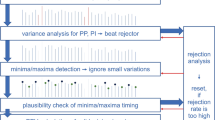Abstract
We recorded finger arterial blood pressure (FINAP) in 50 male patients during various types of surgical operations. Three different types of cuffs were used on four fingers of each patient. Measurements were made by the arterial volume-clamp method of Penaz. The FINAP measurements were compared with pressure data obtained ipsilaterally from a radial artery catheter-transducer system (intraarterial pressure [IAP]) to find optimal recording conditions and to document factors affecting FINAP readings. The thumb, with a specially designed cuff, gave the most accurate results. The mean FINAP- IAP difference for the thumb was −4.8 mm Hg for systolic pressure, 1.49 mm Hg for diastolic pressure, and 0.29 mm Hg for mean pressure. The differences were statistically significant for systolic and diastolic pressure but not for mean pressure. The regression slope for thumb systolic FINAP/IAP was 0.979, that for thumb diastolic FINAP/IAP was 0.963, and that for mean thumb FINAP/IAP was 0.996, whereas the intercepts were 7.499 for systolic pressure, 0.802 for diastolic pressure, and 0.083 for mean pressure. The correlation coefficients were 0.945 (systolic), 0.884 (diastolic), and 0.949 (mean). The correlation coefficients with the other fingers ranged from 0.502 to 0.922 for systolic pressure, 0.757 to 0.932 for diastolic pressure, and 0.767 to 0.892 for mean pressure. The slopes for the various finger-cuff combinations ranged from 0.537 to 0.996, and the intercepts ranged from 0.083 to 32.387 from mean pressure. In 3 patients (6%) the FINAP measurement was not possible because of insufficient peripheral circulation. In 9 other patients (18%) the FINAP measurements were not accurate during some periods of time.
In 5 of those 9 patients the difficulties were related to arterial cannulation and began immediately after cannulation. In 1 of those 5 patients the FINAP subsequently decreased dramatically after the onset of phenylephrine infusion because of peripheral vasoconstriction and diminished blood flow. In the 4 other patients the FINAP readings were accurate at the beginning of anesthesia but later decreased out of proportion to changes in IAP. These periods were associated with one-lung ventilation. The FINAP accurately reflects systemic arterial pressure. Measurements from the thumb fitted with a specially designed cuff approximate IAP best. Factors affecting peripheral circulation must be taken into consideration when this device is used in the monitoring of FINAP.
Similar content being viewed by others
References
Bruner JMR, Krenis LR, Kunsman JM, Sherman AP. Comparison of direct and indirect methods of measuring arterial blood pressure. Med Instrum 1981;15:11–21, 15:97–101, 15:182–188
Messerli FH. Continuous noninvasive automatic blood pressure recording. Postgrad Med 1985;75:115–122
Nakayama R, Azuma T. Noninvasive measurement of digital arterial pressure and compliance in man. Am J Physiol 1977;233:168–178
Peňaz J, Voigt A, Teichmann W. Beitrag zur fortlaufenden indirekten Blutdrucksmessung. Z Inn Med 1976;31:1030–1033
Smith NT, Wesseling KH, de Wit B. Evaluation of the two prototype devices producing noninvasive, pulsatile, calibrated blood pressure measurement from a finger. J Clin Monit 1985;1:17–29
van Egmond J, Hasenbos M, Crul JF. Invasive vs noninvasive measurement of arterial pressure. Br J Anaesth 1985;57:434–444
Wesseling KH, de Wit B, Settels JJ, Klawer WH. On the indirect registration of finger blood pressure after Penaz. Funkt Biol Med 1982;1:245–250
Yamakoshi K, Shimazu H, Togawa T. Indirect measurement of instantaneous arterial blood pressure in the human finger by the vascular unloading technique. IEEE Trans Biomed Eng 1980;27:150–155
Bedford RF, Wellman H. Complications of percutaneous radial artery cannulation. An objective prospective study in man. Anesthesiology 1973;38:228–236
Gillies IDS, Morgan M, Sykes MK, et al. The nature and incidence of complications of peripheral arterial puncture. Anaesthesia 1979;34:506–509
Jones R, Hill AB, Nahrwold ML, et al. The effect of method of radial artery cannulation on postcannulation blood flow and thrombus formation. Anesthesiology 1981;55:76–78
Molhoek P, Wesseling KH, Arntzenius AC, et al. Initial results of noninvasive measurement of finger blood pressure according to Penaz. Automedica 1983;4:241–246
Wesseling KH, Settels JJ, Van der Hoeven GMA, et al. Effects of peripheral vasoconstriction on the measurement of blood pressure in a finger. Cardiovasc Res 1985;19:139–144
Longnecker DE. The microcirculation. In: Prys-Roberts C, ed. Circulation in Anesthesia. Oxford: Blackwell, 1980:167–178
Prys-Roberts C. Regulation of the circulation. In: Prys-Roberts C, ed. Circulation in Anesthesia. Oxford: Blackwell, 1980:179–207
Abboud FM. The sympathetic nervous system in hypertension. Clin Exp Hypertens [A] 1984;6:43–60
Dorlas JC, Nijboer JA, Butijn WT, et al. Effects of peripheral vasoconstriction on the blood pressure in the finger, measured continuously by a new noninvasive method (the Finapres ®). Anesthesiology 1985;62:342–345.
Jänig W. Vasoconstrictor systems supplying skeletal muscle, skin and viscera. Clin Exp Hypertens [A] 1984;6:329–346
Johansson Börje. Vascular smooth muscle reactivity. Annu Rev Physiol 1981;43:359–370
Peňaz J. Photoelectric measurement of blood pressure, volume and flow in the finger. Dig 10th Int Conf Med Biol Eng 1973;104
Nutter DO, Paulk EA. Measuring and recording systemic blood pressure. In: Hurst JW, Logue RB, eds. The heart, arteries and veins. 2nd Ed. New York: McGraw-Hill, 1970:207–219
Gravenstein JS, Paulus DA. Arterial pressure. In: Gravenstein JS, Paulus DA, eds. Monitoring Practice in Clinical Anesthesia. Philadelphia: Lippincott, 1982:32–44
Shaw Wilgis EF, Kaplan EB. The blood supply of the hand. In: Kaplan EB, ed. Kaplan's functional and surgical anatomy of the hand, 3rd ed. Philadelphia: Lippincott, 1984:203–221
Kelman GR. Peripheral circulation and its control. In: Kelman GR, ed. Applied Cardiovascular Physiology 1. London: Butterworths, 1971:63–102
Smith NT, Corbascio AN. The use and misuse of pressor agents. Anesthesiology 1970;33:58–101
Said SI. Metabolic functions of the pulmonary circulation. Circ Res 1982;50:325–333
Gerber JG, Voelkel N, Nies AS, et al. Moderation of hypoxic vasoconstriction by infused arachidonic acid: role of PGI2. J Appl Physiol 1980;49:107–112
Pitt BR. Metabolic functions of the lung and systemic vasoregulation. Fed Proc 1984;43:2574–2577
Author information
Authors and Affiliations
Rights and permissions
About this article
Cite this article
Kurki, T., Ty Smith, N., Head, N. et al. Noninvasive continuous blood pressure measurement from the finger: Optimal measurement conditions and factors affecting reliability. J Clin Monitor Comput 3, 6–13 (1987). https://doi.org/10.1007/BF00770876
Received:
Revised:
Accepted:
Issue Date:
DOI: https://doi.org/10.1007/BF00770876




